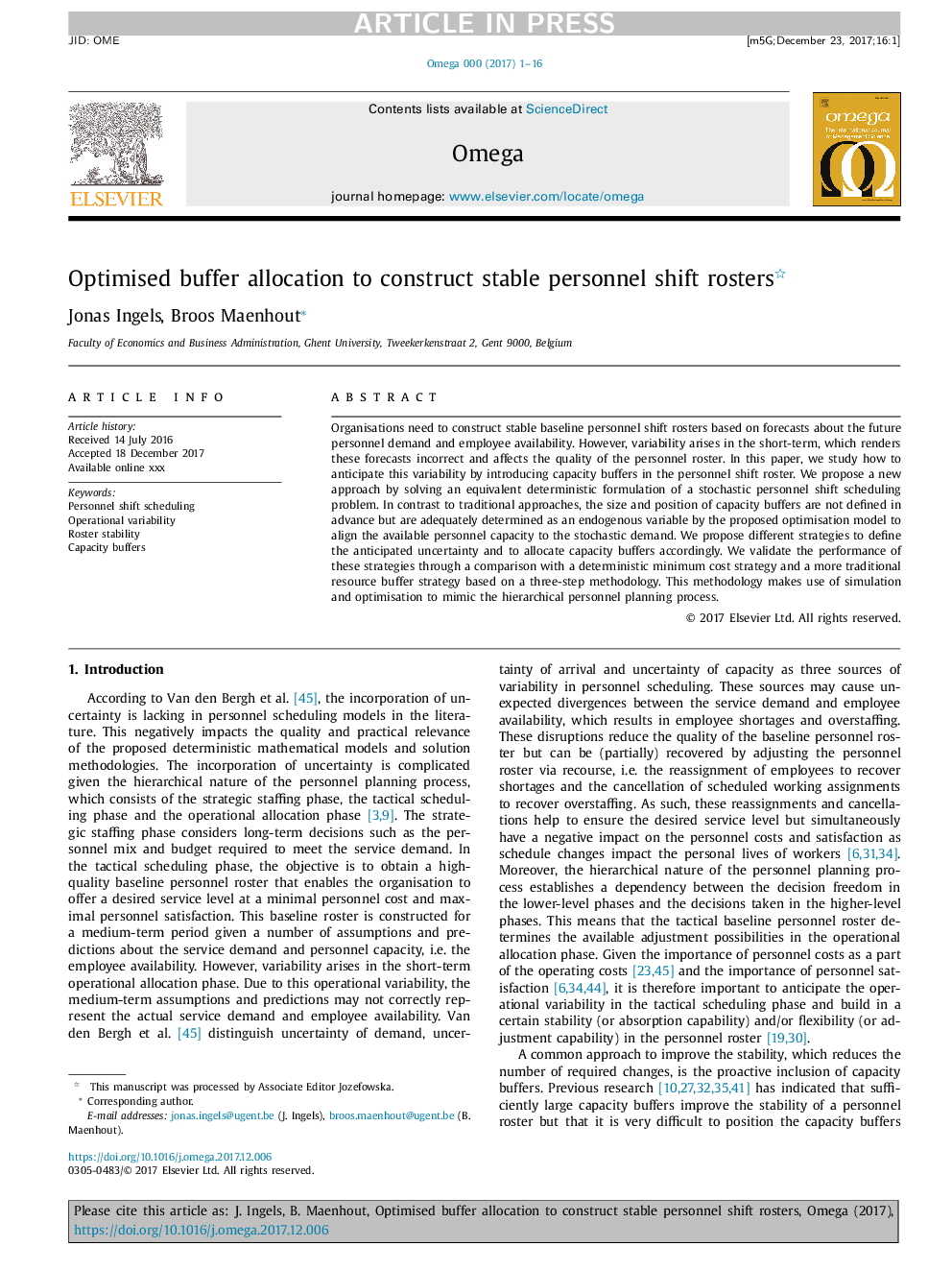| کد مقاله | کد نشریه | سال انتشار | مقاله انگلیسی | نسخه تمام متن |
|---|---|---|---|---|
| 11011918 | 1802847 | 2019 | 16 صفحه PDF | دانلود رایگان |
عنوان انگلیسی مقاله ISI
Optimised buffer allocation to construct stable personnel shift rosters
ترجمه فارسی عنوان
تخصیص بافر بهینه شده برای ایجاد روندهای تغییر شغل پرسنلی
دانلود مقاله + سفارش ترجمه
دانلود مقاله ISI انگلیسی
رایگان برای ایرانیان
کلمات کلیدی
برنامه ریزی تغییر کارکنان، تنوع عملیاتی، ثبات گرداننده، ظرفیت بافر،
ترجمه چکیده
سازمانها نیاز به ایجاد روندهای تغییر شغل پایه پایه بر اساس پیش بینی های مربوط به تقاضای پرسنل آینده و دسترسی کارمندان دارند. با این حال، تغییرات در کوتاه مدت بوجود می آیند، که این پیش بینی ها را نادرست و بر کیفیت لیست کارکنان تاثیر می گذارد. در این مقاله، ما در حال بررسی چگونگی پیش بینی این تغییر پذیری با معرفی بافر های ظرفیت در فهرست تغییر پرسنل می باشیم. ما یک رویکرد جدید را با حل یک فرمولبندی معکوس واضحی از یک برنامه زمانبندی شغلی تصادفی پیشنهاد می دهیم. برخلاف رویکردهای سنتی، اندازه و موقعیت بافرهای ظرفیت پیش از این تعریف نشده است، اما به واسطه مدل پیشنهادی بهینه سازی شده برای تعدیل ظرفیت پرسنل موجود به تقاضای تصادفی به عنوان یک متغیر درونی تعیین می شود. ما پیشنهاد می کنیم استراتژی های مختلفی برای تعریف عدم اطمینان پیش بینی شده و به ترتیب بافر های ظرفیتی را اختصاص دهیم. ما عملکرد این استراتژی ها را با مقایسه با یک استراتژی حداقل هزینه قطعی و یک استراتژی بافر سنتی منابع مبتنی بر یک روش سه مرحله ای تأیید می کنیم. این روش از شبیه سازی و بهینه سازی استفاده می کند تا تقلید از روند برنامه ریزی پرسنل سلسله مراتبی.
موضوعات مرتبط
علوم انسانی و اجتماعی
مدیریت، کسب و کار و حسابداری
استراتژی و مدیریت استراتژیک
چکیده انگلیسی
Organisations need to construct stable baseline personnel shift rosters based on forecasts about the future personnel demand and employee availability. However, variability arises in the short-term, which renders these forecasts incorrect and affects the quality of the personnel roster. In this paper, we study how to anticipate this variability by introducing capacity buffers in the personnel shift roster. We propose a new approach by solving an equivalent deterministic formulation of a stochastic personnel shift scheduling problem. In contrast to traditional approaches, the size and position of capacity buffers are not defined in advance but are adequately determined as an endogenous variable by the proposed optimisation model to align the available personnel capacity to the stochastic demand. We propose different strategies to define the anticipated uncertainty and to allocate capacity buffers accordingly. We validate the performance of these strategies through a comparison with a deterministic minimum cost strategy and a more traditional resource buffer strategy based on a three-step methodology. This methodology makes use of simulation and optimisation to mimic the hierarchical personnel planning process.
ناشر
Database: Elsevier - ScienceDirect (ساینس دایرکت)
Journal: Omega - Volume 82, January 2019, Pages 102-117
Journal: Omega - Volume 82, January 2019, Pages 102-117
نویسندگان
Jonas Ingels, Broos Maenhout,
